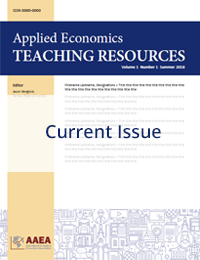Teaching and Educational Methods
Coordinating Environmental and Trade Policy to Protect the Environment: A Pedagogical Approach
Patrik T. Hultberg(a) and Darshana Udayanganie(a)
Kalamazoo College(a)
JEL Codes: A20, F18, Q58
Keywords: Keywords: Environment, international trade, teaching of economics
First Published Online: April 26, 2022
Volume 4, Issue 4
Abstract
Abstract: Establishing appropriate environmental and trade policies is an important issue in today’s globalized economy, and yet there is no comprehensive analysis in most environmental economics and international trade undergraduate textbooks of how such policies are interrelated. The purpose of this article is to provide a straightforward framework for teaching students how environmental and trade policies are indeed interconnected, utilizing the standard tools of intermediate microeconomics. Focusing on a single competitive market and (nonstrategic) welfare maximizing government, optimal environmental and trade policies are derived and explored. The framework is used to address several circumstances, including negative production and consumption externalities, small and large countries, and transboundary pollution.
References
Anderson, K. 1992. “Agricultural Trade Liberalisation and the Environment: A Global Perspective.” The World Economy 15(1):153–172. https://doi.org/10.1111/j.1467-9701.1992.tb00801.x.
Balistreri, E.J., D.T. Kaffine, and H. Yonezawa. 2019. “Optimal Environmental Border Adjustments Under the General Agreement on Tariffs and Trade.” Environmental and Resource Economics 74(3):1037–1075. https://doi.org/10.1007/s10640- 019-00359-2.
Bhagwati, J.N. 1971. “The Generalized Theory of Distortions and Welfare.” In J.N. Bhagwati, R. Jones, R. Mundell, and J. Vanek, ed. Trade, Balance of Payments, and Growth: Papers in International Economics in Honor of Charles P. Kindleberger. Amsterdam: North-Holland, pp. 69–90.
Britten-Jones, M., R.S. Nettle, and K. Anderson. 1987. “On Optimal Second-Best Trade Intervention in the Presence of a Domestic Divergence.” Australian Economic Papers 26(December):332–336. https://doi.org/10.1111/j.1467- 8454.1987.tb00513.x.
Böhringer, C., J. Schneider, and E. Asane-Otoo. 2021. “Trade in Carbon and Carbon Tariffs.” Environmental and Resource Economics 78(4):669–708.
Esty, D.C. 1994. Greening the GATT: Trade, Environment, and the Future. Washington DC: Institute for International Economics.
Esty, D.C. 2001. “Bridging the Trade-Environment Divide.” Journal of Economic Perspectives 15(3):113–130.
European Commission. 2021. “Carbon Border Adjustment Mechanism: Questions and Answers.” https://ec.europa.eu/commission/presscorner/detail/en/qanda_21_3661.
Friedman, L. 2021. “Democrats Propose a Border Tax Based on Countries’ Greenhouse Gas Emissions.” New York Times, July 19. https://www.nytimes.com/2021/07/19/climate/democrats-border-carbon-tax.html?searchResultPosition=1.
Hultberg, P.T., and E.B. Barbier. 2004. “Cross-Country Policy Harmonization with Rent-Seeking.” Contributions to Economic Analysis and Policy 3(2):1–20.
Krutilla, K. 1991. “Environmental Regulation in an Open Economy.” Journal of Environmental Economics and Management 20:127–142.
Krutilla, K. 2002. “Partial Equilibrium Models of Trade and the Environment.” In J.C.J.M. van den Bergh, ed. Handbook of Environmental and Resource Economics. Cheltenham: Edward Elgar Publishing, pp. 404–415.
Lewis, L.Y. 2011. “A Virtual Field Trip to the Real World of Cap and Trade: Environmental Economics and the EPA SO2 Allowance Auction.” The Journal of Economic Education 42(4):354–365.
Mehling, M.A., H.V. Asselt, K. Das, S. Droege, and C. Verkuijl. 2019. “Designing Border Carbon Adjustments for Enhanced Climate Action.” The American Journal of International Law 113(3):433–481.
Metcalf, G.E. 2019. “On the Economics of a Carbon Tax for the United States.” In Brookings Papers on Economic Activity: BPEA Conference Drafts. Washington DC: Brookings Institution, pp. 405–458.
Michalek, G. 2016. “Progressive Optimal Technology-Based Border Carbon Adjustment (POT BCA)—A New Approach to an Old Carbon Problem.” Environmental Modeling & Assessment 21(3):323–337.
Monjon, S., and P. Quirion. 2011. “A Border Adjustment for the EU ETS: Reconciling WTO Rules and Capacity to Tackle Carbon Leakage.” Climate Policy 11(5):1212–1225.
OECD. 2019. Trade and the Environment: How Are Trade and Environmental Sustainability Compatible? https://www.oecd.org/trade/topics/trade-and-the-environment/.
Plumer, B. 2021. “Europe Is Proposing a Border Carbon Tax. What Is It and How Will It Work?” New York Times, July 14. https://www.nytimes.com/2021/07/14/climate/carbon-border-tax.html.
Wiers, J. 2008. “French Ideas on Climate and Trade Policies.” Carbon & Climate Law Review 2(1):18–32.
World Trade Organization. 1994. Article XX General Exceptions. Analytical Index of the GATT. https://www.wto.org/english/res_e/booksp_e/gatt_ai_e/art20_e.pdf.
World Trade Organization. 2021. WTO: Trade and Environment. https://www.wto.org/english/tratop_e/envir_e/envir_e.htm.
Articles in this issue
Who Fills the Seats? Offering Extra Credit and Instructor Perceptions of Who Will Attend
Joshua J. Lewer, Colin Corbett, Tanya M. Marcum, and Jannett Highfill
Teaching Forward Contracts in Undergraduate Courses in Agribusiness and Agricultural Economics Programs
Yuliya V. Bolotova
Coordinating Environmental and Trade Policy to Protect the Environment: A Pedagogical Approach
Patrik T. Hultberg and Darshana Udayanganie
Price-Fixing in the U.S. Broiler Chicken and Pork Industries
Yuliya V. Bolotova
Economic Dynamics in the Beef Food Supply Chain under Pandemic Conditions
Grace Melo, Luis Pena-Levano, and Kori Luengo
The Empathetic Course Design Perspective
Donald A. Saucier, Tucker L. Jones, Ashley A. Schiffer, and Noah D. Renken


